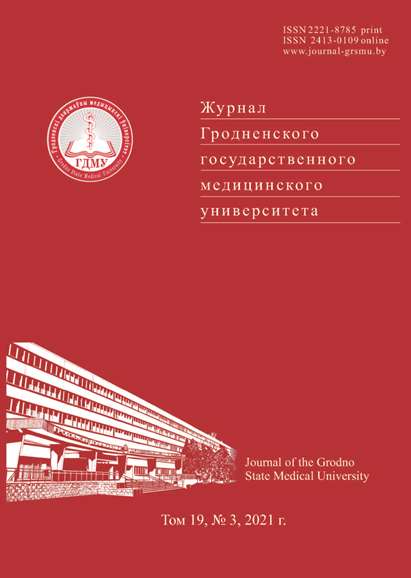МОРФОЛОГИЧЕСКИЕ ИЗМЕНЕНИЯ СОСУДИСТОЙ СИСТЕМЫ ПЕЧЕНИ КРЫС ПОД ВОЗДЕЙСТВИЕМ ТИОАЦЕТАМИДА

Аннотация
Введение. Анализ литературы показал, что ангиогенез играет ключевую роль в прогрессировании фиброза печени. Однако имеющиеся научные сообщения о морфологических изменениях сосудистой системы печени недостаточны и противоречивы.
Цель работы – исследование морфологических изменений сосудистой системы печени крыс под воздействием тиоацетамида.
Материал и методы. Фиброз и цирроз печени у крыс Wistar индуцировали тиоацетамидом в дозе 200 мг/кг веса животного в течение 17 недель. Для исследования морфологических изменений использовали классический и иммуногистохимический методы окраски гистологических препаратов. Микроскопический анализ проводили с использованием микроскопа OLYMPUS BX51 и программ анализа изображений ImageScope Color и cellSens Standard.
Результаты. Внутрижелудочное введение животным раствора тиоацетамида приводит к плавному нарастанию прогрессии патологических изменений и позволяет отследить все стадии развития цирроза и морфологическую перестройку сосудистой системы печени. На протяжении всего эксперимента происходили интенсивная капилляризация синусоидов паренхимы, неоангиогенез в портальных трактах и соединительнотканных септах, который проявлялся формированием множества венул и мелких вен; увеличение площади междольковых вен, местами достигших гигантских размеров.
Выявлены три морфологических фенотипа CD34-позитивных клеток: в междольковых артериях, междольковых, центральных и поддольковых венах данные клетки имели вытянутую форму и палочковидное темноокрашенное ядро; при трансформации фиброза печени в цирроз в синусоидах (ближе к периферии отдельных ложных узелков) отмечались CD34-позитивные клетки вытянутой формы со светлыми округло-вытянутыми ядрами; в соединительной ткани около печёночных триад, в соединительнотканных септах среди клеток инфильтрата и между резко увеличенным количеством желчных протоков наблюдались клетки округлой формы с темноокрашенными ядрами.
Выводы. Установленные сложные фенотипические изменения синусоидальных эндотелиальных клеток доказывают тесную связь фиброгенеза с неоангиогенезом и, вероятно, они играют ведущую роль в развитии фиброза и перестройке венозной системы портальной вены.
Литература
He Z, Yang D, Fan X, Zhang M, Li Y, Gu X. The roles and mechanisms of lncRNAs in liver fibrosis. Int. J. Mol. Sci. 2020;21(4):1482. https://doi.org/10.3390/ijms21041482
Roehlen N, Crouchet E, Baumert TF. Liver fibrosis: Mechanistic concepts and therapeutic perspectives. Cells. 2020;9(4):875. https://doi.org/10.3390/cells9040875
An P, Wei LL, Zhao S, Sverdlov DY, Vaid KA, Miyamoto M, Kuramitsu K, Lai M, Popov YV. Hepatocyte mitochondria-derived danger signals directly activate hepatic stellate cells and drive progression of liver fibrosis. Nat. Commun. 2020;11(1):2362. https://doi.org/10.1038/s41467-020-16092-0
Ramirez-Pedraza M, Fernаndez M. Interplay between macrophages and angiogenesis: A double-edged sword in liver disease. Front. Immunol. 2019;10:2882. https://doi.org/10.3389/fimmu.2019.02882
Lafoz E, Ruart M, Anton A, Oncins A, Hernаndez-Gea V. The endothelium as a driver of liver fibrosis and regeneration. Cells. 2020;9(4):929. https://doi.org/10.3390/cells9040929
Wang L, Feng Y, Xie X, Wu H, Nan Su X, Qi J, Xin W, Gao L, Zhang Y, Shah V H, Zhu Q. Neuropilin-1 aggravates liver cirrhosis by promoting angiogenesis via VEGFR2-dependent PI3K/Akt pathway in hepatic sinusoidal endothelial cells. BioMedicine. 2019;43:525-536. https://doi.org/10.1016/j.ebiom.2019.04.050
Duan JL, Ruan B, Yan XC, Liang L, Song P, Yang ZY, Liu Y, Dou KF, Han H, Wang L. Endothelial Notch activation reshapes the angiocrine of sinusoidal endothelia to aggravate liver fibrosis and blunt regeneration in mice. Hepatology. 2018;68(2):677-690. https://doi.org/10.1002/hep.29834
Hou W, Syn WK. Role of Metabolism in hepatic stellate cell activation and fibrogenesis. Front Cell Dev. Biol. 2018;6:150. https://doi.org/10.3389/fcell.2018.00150
Ni Y, Li JM, Liu MK, Zhang TT, Wang DP, Zhou WH, Hu LZ, Lv WL. Pathological process of liver sinusoidal endothelial cells in liver diseases. World J. Gastroenterol. 2017;23(43):7666-7677. https://doi.org/10.3748/wjg.v23.i43.7666
Yan X, Wang Z, Kai J, Wang F, Jia Y, Wang S, Tan S, Shen X, Chen A, Shao J, Zhang F, Zhang Z, Zheng S. Curcumol attenuates liver sinusoidal endothelial cell angiogenesis via regulating Glis-PROX1-HIF-1α in liver fibrosis. Cell Prolif. 2020;53(3):e12762. https://doi.org/10.1111/cpr.12762
Garbuzenko DV, Arefyev NO, Kazachkov EL. Antiangiogenic therapy for portal hypertension in liver cirrhosis: Current progress and perspectives. World J. Gastroenterol. 2018;24(33):3738-3748. https://doi.org/10.3748/wjg.v24.i33.3738
Carmeliet P, Jain RK. Molecular mechanisms and clinical applications of angiogenesis. Nature. 2011;473(7347):298-307. https://doi.org/10.1038/nature10144
Garbuzenko DV, Arefyev NO, Belov DV. Mechanisms of adaptation of the hepatic vasculature to the deteriorating conditions of blood circulation in liver cirrhosis. World J. Hepatol. 2016;8(16):665-72. https://doi.org/10.4254/wjh.v8.i16.665
Kasprzak A, Adamek A. Role of endoglin (CD105) in the progression of hepatocellular carcinoma and anti-angiogenic therapy. Int. J. Mol. Sci. 2018;19(12):3887. https://doi.org/10.3390/ijms19123887
Lee TY, Leu YL, Wen C-K. Modulation of HIF-1α and STAT3 signaling contributes to anti-angiogenic effect of YC-1 in mice with liver fibrosis. Oncotarget. 2017;8(49):86206-86216. https://doi.org/10.18632/oncotarget
Dweep H, Morikawa Y, Gong B, Yan J, Liu Z, Chen T, Bisgin H, Zou W, Hong H, Shi T, Gong P, Castro C, Uehara T, Wang Y, Tong W. Mechanistic roles of microRNAs in hepatocarcinogenesis: A study of thioacetamide with multiple doses and time-points of rats. Sci. Rep. 2017;7(1):3054. https://doi.org/10.1038/s41598-017-02798-7
Muthiah MD, Huang DQ, Zhou L, Jumat NH, Choolani M, Chan JKY, Wee A, Lim S Gee, Dan Y-Y. A murine model demonstrating reversal of structural and functional correlates of cirrhosis with progenitor cell transplantation. Sci. Rep. 2019;9(1):15446. https://doi.org/10.1038/s41598-019-51189-7
Everhart JE, Wright EC, Goodman ZD, Dienstag JL, Hoefs JC, Kleiner DE, Ghany MG, Mills AS, Nash SR, Govindarajan S, Rogers TE, Greenson JK, Brunt EM, Bonkovsky HL, Morishima C, Litman H J, Trial Group HC. Prognostic value of Ishak fibrosis stage: findings from the hepatitis C antiviral long-term treatment against cirrhosis trial. Hepatology. 2010;51(2):585-594. https://doi.org/10.1002/hep.23315
Peeters G, Debbaut C, Friebel A, Cornillie P, De Vos WH, Favere K, Elst IV, Vandecasteele T, Johann T, Hoorebeke LV, Monbaliu D, Drasdo D, Hoehme S, Laleman W, Segers P. Quantitative analysis of hepatic macro- and microvascular alterations during cirrhogenesis in the rat. J. Anat. 2018;232(3):485-496. https://doi.org/10.1111/joa.12760
Vanheule E, Geerts AM, Van Huysse J, Schelfhout D, Praet M, Van Vlierberghe H, De Vos M, Colle I. An intravital microscopic study of the hepatic microcirculation in cirrhotic mice models: relationship between fibrosis and angiogenesis. Int. J. Exp. Pathol. 2008;89(6):419-432. https://doi.org/10.1111/j.1365-2613.2008.00608.x
Hammoutene A, Rautou PE. Role of liver sinusoidal endothelial cells in non-alcoholic fatty liver disease. J. Hepatol. 2019;70(6):1278-1291. https://doi.org/10.1016/j.jhep.2019.02.012
Sato K, Marzioni M, Meng F, Francis H, Glaser S, Alpini G. Ductular reaction in liver diseases: pathological mechanisms and translational significances. Hepatology. 2019;69(1):420-430. https://doi.org/10.1002/hep.30150






























